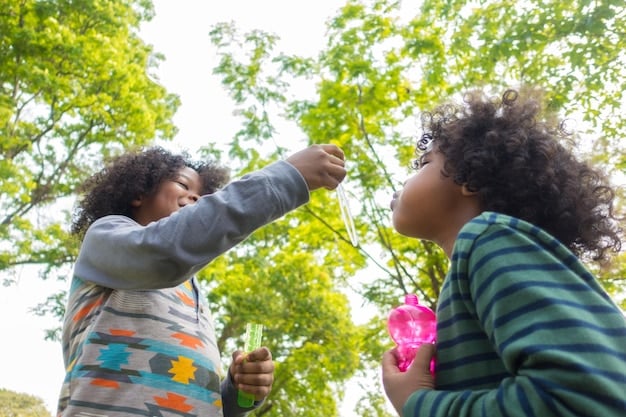Child Safety: Protecting Kids from Abduction & Exploitation

Child safety involves comprehensive measures to protect children from dangers like abduction and exploitation through education, awareness, and proactive safety strategies.
Ensuring child safety: protecting your children from abduction and exploitation is paramount in today’s world. Understanding the risks and implementing proactive measures can significantly safeguard children, providing peace of mind for parents and a safer environment for kids to grow and thrive.
Understanding the Risks of Child Abduction and Exploitation
Child abduction and exploitation are serious concerns that require heightened awareness. Knowing the potential dangers is the first step in protecting your children effectively.
These crimes can occur in various settings, making it essential for parents and guardians to stay informed and vigilant.
Defining Child Abduction
Child abduction involves the unlawful taking and detention of a minor, often by a non-custodial parent or a stranger. Understanding the different types of abduction can help parents recognize and prevent these situations.
Exploitation Defined
Child exploitation includes any activity that uses a child for someone else’s advantage, often for financial gain or sexual gratification. This can take many forms including online and physical interactions.
- Stranger Abduction: When a child is taken by someone unknown to them.
- Familial Abduction: Often occurs during custody disputes, where a parent takes the child without legal permission.
- Online Exploitation: Involves grooming and manipulation through online platforms.
- Labor Exploitation: Forcing children into labor or servitude.
Recognizing these risks lets you take the correct preventative measures.

Creating a Safe Home Environment
A safe home environment is crucial for child safety: protecting your children from abduction and exploitation. This involves both physical security and emotional well-being.
By establishing clear boundaries and open communication, you create a space where children feel secure and comfortable sharing their concerns.
Physical Security Measures
Enhancing the physical security of your home reduces the risk of unauthorized access and potential harm.
Open Communication
Encourage your children to communicate openly with you about their experiences, fears, and concerns.
- Secure Doors and Windows: Install sturdy locks and consider security systems.
- Monitor Digital Devices: Use parental controls to restrict access to inappropriate content.
- Establish Family Rules: Set clear rules about strangers, answering the door, and personal safety.
- Regular Check-Ins: Schedule regular conversations to discuss their day and any concerns.
A secure home environment and open communication can help prevent both physical and emotional dangers.
Teaching Children Personal Safety Skills
Equipping children with personal safety skills empowers them to recognize and respond to potential threats effectively. These skills are invaluable in various situations.
Teaching children how to assert themselves and make safe choices can significantly reduce their vulnerability.

‘Stranger Danger’ Education
Though the concept of “stranger danger” has evolved, teaching children to be cautious around unfamiliar individuals is still essential.
Assertiveness and Self-Defense
Encourage your child to assert themselves when they feel uncomfortable or threatened. Learning basic self-defense techniques can also boost their confidence and ability to protect themselves.
- Teach to Say “NO”: Empower them to refuse unwanted attention or requests.
- “Check First” Rule: Always check with a trusted adult before going anywhere with someone.
- Basic Self-Defense Moves: Simple techniques to escape from a potential attacker.
- Trust Their Instincts: If something feels wrong, it probably is; teach them to trust their gut feelings.
Empowering children with these defense skills and awareness helps to keep them from dangerous scenarios.
Online Safety and Social Media Awareness
The digital age presents unique challenges for child safety: protecting your children from abduction and exploitation. Monitoring your child’s online activity and educating them about online safety are critical.
Teach them how to protect their personal information and recognize potential online predators.
Monitoring Online Activity
Keep track of your child’s online interactions, but do so in a way that respects their privacy while ensuring their safety.
Understanding Cyberbullying
Cyberbullying can have devastating effects on children. Educate your child about how to recognize, respond to, and report cyberbullying.
- Privacy Settings: Adjust social media settings to limit who can see their profiles and posts.
- Safe Browsing Habits: Teach them to avoid clicking on suspicious links or downloading unknown files.
- Reporting Mechanisms: Show them how to report inappropriate behavior on different platforms.
- Open Dialogue: Discuss the dangers of sharing personal information online.
Staying informed about online safety can protect against cyberbullying, and predators.
Community Involvement and Awareness Programs
Community involvement plays a vital role in enhancing child safety child safety: protecting your children from abduction and exploitation. Participating in local programs and events promotes a safer environment for all children.
Collaborating with neighbors, schools, and local organizations can create a strong support network and increase awareness of potential dangers.
Neighborhood Watch Programs
Participating in neighborhood watch programs increases vigilance and cooperation among residents, creating a safer community for children.
School Safety Initiatives
Engaging with schools and supporting their safety initiatives helps create secure learning environments for children.
- Local Safety Events: Attend community events focused on child safety and crime prevention.
- Awareness Campaigns: Support campaigns that raise awareness about child abduction and exploitation.
- Volunteer Opportunities: Volunteer for programs that support children and families in your community.
- Partnerships with Law Enforcement: Collaborate with local police to address safety concerns.
Working together creates opportunities to create a safer community for children.
Legal and Law Enforcement Resources
Knowing the legal resources and how to contact law enforcement is crucial in cases of child abduction or exploitation. Familiarize yourself with the relevant laws and support services available.
Having this knowledge ensures that you can take swift and appropriate action if a child is threatened or harmed.
Reporting Procedures
Understand the proper procedures for reporting suspected cases of child abduction or exploitation to law enforcement agencies.
Support Services
Familiarize yourself with organizations that offer support and assistance to victims of child abduction and exploitation and their families.
- National Center for Missing and Exploited Children (NCMEC): Provides resources, support, and assistance in locating missing children.
- Local Law Enforcement Contacts: Keep a list of local police departments and emergency contact numbers readily available.
- Legal Aid Services: Know where to find legal assistance if you need to navigate custody disputes or other legal issues.
- Child Protective Services (CPS): Understand the role of CPS in investigating and addressing cases of child abuse and neglect.
Understanding legal and law enforcement resources prepares you for prompt action.
| Key Point | Brief Description |
|---|---|
| 📢 Education | Teach children personal safety skills and online awareness. |
| 🏠 Safe Home | Secure your home and create an open communication environment. |
| 🌐 Online Monitoring | Monitor online activity, especially social media, and adjust privacy settings. |
| 🚓 Law Enforcement | Understand reporting procedures and support services available. |
Child Safety FAQ
▼
Common forms include stranger abduction, where a child is taken by an unknown person, and familial abduction, often during custody disputes, by a parent.
▼
Enhance physical security with sturdy locks and security systems. Monitor digital devices with parental controls. Establish clear family rules about safety and communication.
▼
It’s wise to teach children to be cautious around unfamiliar individuals. They must have the confidence to say “NO”, and know to always check with a trusted adult first.
▼
Monitor their online activity, adjust privacy settings on social media, and teach them safe browsing habits, such as avoiding suspicious links and reporting inappropriate behavior.
▼
Get associated with neighborhood watch programs, school safety initiatives, local safety events, and volunteer opportunities with organizations that support children and families.
Conclusion
Ultimately, protecting children from abduction and exploitation requires a comprehensive and proactive approach. By staying informed, teaching children essential safety skills, and engaging with your community, you can create a safer environment for children to grow and thrive.





